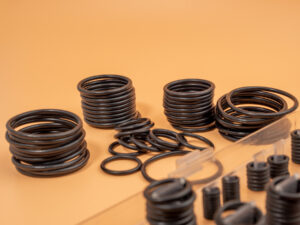Understanding how synthetic rubber is made allows manufacturers to produce a wider range of products for use in both industrial and consumer markets. From tubing to tires, o-rings to gaskets, and sneakers to basketballs, synthetic rubber is an indispensable material used in the manufacture of countless goods and products around the globe. Knowing how synthetic rubber is made gives manufacturers control over its composition and customization to meet the requirements of applications for particular industries and sectors. Let’s examine how synthetic rubber is made, its advantages, and common uses.
How Synthetic Rubber Is Made
 Synthetic rubber is a man-made elastomer, a material with elastic-like properties that is produced from petroleum byproducts. An elastomer is, technically, a pliable polymer, or plastic material, with viscoelasticity, meaning, its properties have both viscosity and elasticity, which gives it the ability to recover to its original form after being compressed, stretched, or deformed.
Synthetic rubber is a man-made elastomer, a material with elastic-like properties that is produced from petroleum byproducts. An elastomer is, technically, a pliable polymer, or plastic material, with viscoelasticity, meaning, its properties have both viscosity and elasticity, which gives it the ability to recover to its original form after being compressed, stretched, or deformed.
The production process of synthetic rubber follows several important steps, some of which may be altered slightly depending on the type of rubber being produced. They are principally derived from a range of petrochemical monomers like styrene, butadiene, ethylene, propylene, or isoprene. Selection depends on the desired properties of the product. Monomers are molecules that can be bonded to other identical molecules and formed into a polymer. When desired monomer molecules are selected, they react together to form extended polymer chains, essentially three-dimensional networks with specific characteristics, that form rubbery substances.
Once this polymerization process has been completed, then, the material undergoes vulcanization to enhance the properties of the newly formed rubber into a more durable material. Vulcanization involves adding sulfur, an accelerator, and then applying heat, which strengthens the material, increases its elasticity, and boosts its resistance to temperature changes. The finished rubber product can then be molded into a desired shape.
Not all synthetic rubbers are derived from petrochemicals. One notable exception is silicone, which is formed by polymerization of silicon from sand or quartz. Rather than carbon-based, silicone’s backbone is composed of silicon-oxygen.
The Advantages of Synthetic Rubbers
Synthetic rubber is a material that possesses excellent mechanical and physical properties such as dimensional stability, strength, and resilience. One of its key characteristics is a low modulus of elasticity, which allows it to sustain deformation up to 1000 percent before retracting quickly and forcibly back to its original dimensions.
The material also has excellent dampening properties, can be used for electrical insulation, has impact and abrasion resistance, and can function in a broad temperature range. It has a low permeability, too, which makes it an ideal sealing material that can resist the passage of air, gasses, solvents, moisture, steam, chemicals, water, and other fluids and substances.
Synthetic rubber often exhibits superior durability and resistance to wear, tear, and environmental factors compared to natural rubber. Products made with synthetic rubber tend to have a longer lifespan, reducing maintenance costs and enhancing end-user reliability.
Many synthetic rubber formulations offer enhanced resistance to weathering, UV radiation, and chemicals. This resistance makes synthetic rubber suitable for outdoor applications and environments where exposure to harsh conditions or corrosive substances is common. Manufacturers can tailor the properties of synthetic rubber to meet the specific needs of different applications. This level of customization allows for the creation of specialized rubber products optimized for performance in specific conditions.
Common Industrial Applications for Synthetic Rubber
Synthetic rubber is an exceptionally versatile material that serves various industrial applications. As the primary material for o-rings and gaskets, synthetic rubbers create airtight and watertight seals for industrial machinery and automotive engines. They are used to seal pumps, valves, pipe fittings, and vacuum seals in various oil and gas components, public waterwork facilities, and wastewater treatment plants. The aerospace industry uses synthetic rubbers for gaskets, seals, and components that withstand harsh environmental conditions.
As a durable, weather-resistant construction material, synthetic rubber is used in roofing materials, sealants, and adhesives. The medical industry looks to the hypoallergenic properties that synthetic rubbers hold for manufacturing medical products like gloves, tubing, seals, and other equipment, components, and devices. Not in medical tubing applications synthetic rubbers are also utilized in producing flexible hoses and tubing in various industries for conveying liquids and gases. Synthetic rubbers also are used in electrical insulation materials and components for electronic devices.
The automotive industry and vehicle manufacturers of all kinds turn to synthetic rubbers not just for the manufacture of gaskets and seals but also serve as the primary material for manufacturing tires and various automotive parts like belts, hoses, engine mounts, wiper blades, rubber bumpers, grommets and more. Synthetic rubbers transmit materials in factories, whether for conveyor belts on assembly lines or vibration dampening of rollers and bearings in a production plant.
Contact the Experts at Manufacturer’s Rubber & Supply
If your company is in the market for synthetic rubber or if you have questions concerning synthetic rubber, contact our team at Manufacturer’s Rubber & Supply today. We are your trusted source and leader in any rubber product needs. We offer years of expertise and extensive resource support to ensure all needs are met to your satisfaction.

